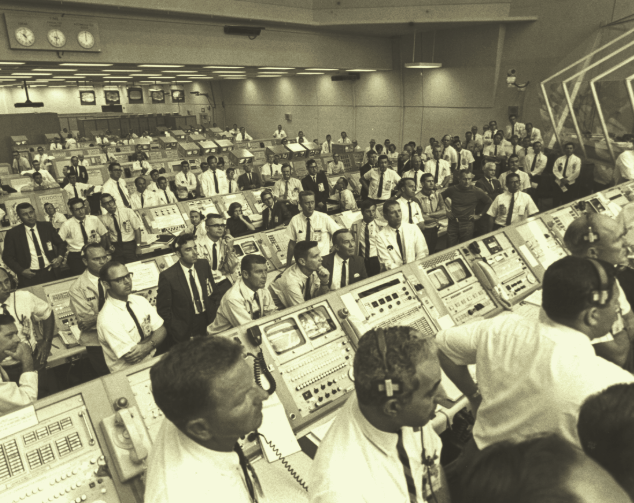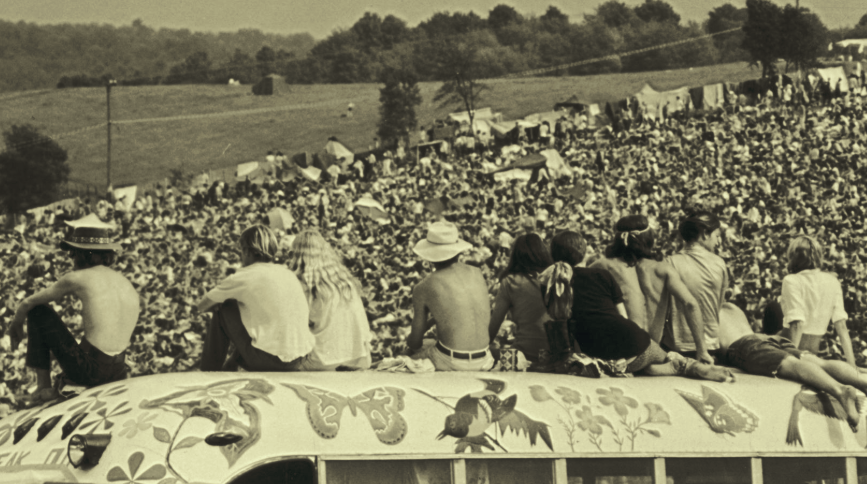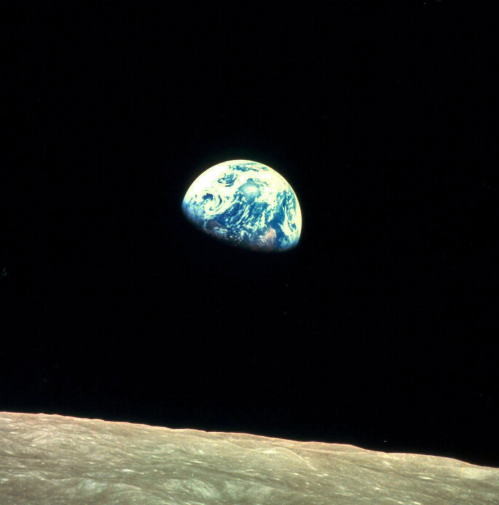July 24, 2019
NASA, Woodstock and The Search For Identity
The two images below were taken a month apart:

The launch of Apollo 11 in mid July 1969 on its way to the moon with three astronauts.
And this photo taken mid August 1969:

Woodstock, August 1969.
It’s hard to think of two events so close in time, and location, yet more distant in terms of philosophy. There at Woodstock it was free love, alternate lifestyle and wear what you want, if anything at all. Oh and Hendrix, Ravi Shankar, The Who, Joe Cocker, and Joan Baez, among the many superstars.
Meanwhile out among the stars, the new-fangled cassette tapes of Neil Armstrong and Buzz Aldrin contained a 1940s album Music For the Moon, and the easy listening that Aldrin loved so much. Galveston by Jimmy Webb sung by Glen Campbell anyone? And there in the space centre it was shirts and ties and pen clips, and one – yes one – woman allowed in the firing room on the day of the launch. And The Sinatra number Fly Me To The Moon was the first song to be played on the surface. Rebel, rebel eh?
Looking at those two photographs reveals that throughout the 1960s there were two parallel universes being explored in earnest. There was an outer space race, a search that was outward and communal. And there was an inner space race, the super nova of the Sexual Revolution, a search that was within and individual, powered by the alternate trinity of sex and drugs and rock’n’roll.
At the start of that decade, May 1961, JFK said he wanted to put a man on the moon by the end of the decade. And, despite his death, they did it. NASA pushed the space revolution beyond the stratosphere. Mission accomplished.
And in early 1964, just months after JFK’s assassination, four Merseyside lads from the UK landed on US shores. By the end of the decade, having started a career and ending it within eight years they rivalled Armstrong as the most famous people on the planet. Along they way they had helped push the Boomers’ into and through a Sexual Revolution and into a search for meaning outside conventional time and space. It’s astonishing to think the Beatles went from “I Want to Hold Your Hand” to “Why Don’t We Do It In The Road?” in such a short time. Or that George Harrison would go from bowl cut to Eastern mystic. Mission accomplished.
Yet It would be fair to say that despite the timing of NASA and Woodstock, both quests tracked each other in the desire for a better world. It’s just that one turned its gaze upwards and one turned its gaze inwards.
There was a great optimism that the outer space push that fuelled technological advancement could unite humanity. It would encourage global peace and camaraderie. This outer space pursuit would enable us to find our better selves, and who knows, perhaps find others out there even better than ourselves who could teach us their ways.
And despite the fact that the Sexual Revolution spawned the search inward for true identity, it too had the lofty goal of world peace and the desire for us to be our better selves. And this was in the midst of the Vietnam War. It doesn’t feel like they were too far apart after all. Vastly different on the surface, if music and clothing is anything to go by, but closely aligned in desire. If you like, both were on a search for something to transcend who and what we were.
In the fifty years that have followed, in the West at least, it would be fair to say that the inner space race has won the day, at least in terms of popular imagination, and certainly in terms of how we seek transcendence.
There is talk of course of going back to the moon, indeed many ventures have gone further (life on Mars anyone?), but nothing has quite captured us as that event did in July 1969. That only another ten or so men – and it was all men – walked on the moon shows that the effort to get there was exhausting.
Conversely, the inner space race continues unabated. The Sexual Revolution shows no sign of running out of steam, even as we push further and further into our selves to discover our true identity, especially through gender and sexual expression. Space is still the final frontier. It’s just that for now our hope seems to lie in searching the depths of inner space. There are myriad planets out there, but we’re still looking to discover ourselves deep, deep down.
And perhaps that’s what makes this last photograph all the more remarkable:

No, not the first photo of earth from the moon, that honour goes to this 1966 picture from a lunar orbiter, but this was the first taken by humans orbiting the moon, looking back at our blue planet.
We went to the moon and discovered the earth. We went to the moon and looked back at how fragile and strung out in space we were. All those teeming masses. Interestingly the three astronauts read Genesis1:1-10 from the King James Bible to mark the occasion.
We all want something more than science can offer us. We still want transcendence, even if we think science can offer it. That’s what makes that most hard-headed of popular rationalists, Lawrence Krauss, say this:
Every atom in your body came from a star that exploded. And, the atoms in your left hand probably came from a different star than your right hand. It really is the most poetic thing I know about physics: You are all stardust. You couldn’t be here if stars hadn’t exploded, because the elements – the carbon, nitrogen, oxygen, iron, all the things that matter for evolution and for life – weren’t created at the beginning of time. They were created in the nuclear furnaces of stars, and the only way for them to get into your body is if those stars were kind enough to explode. So, forget Jesus. The stars died so that you could be here today.
It’s almost right Lawrence, almost. The One who made the stars died so that you could be here today. He was kinder than any star could ever be. Your search for transcendence ended just one level short. He flung the stars into outer space, and can reach to the depths of your inner space and shape your – and my – identity far more than NASA or Woodstock ever could.
Written by
There is no guarantee that Jesus will return in our desired timeframe. Yet we have no reason to be anxious, because even if the timeframe is not guaranteed, the outcome is! We don’t have to waste energy being anxious; we can put it to better use.
Stephen McAlpine – futureproof
Stay in the know
Receive content updates, new blog articles and upcoming events all to your inbox.


